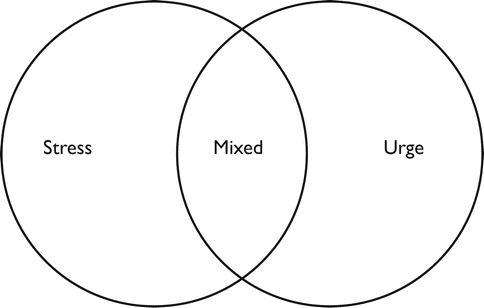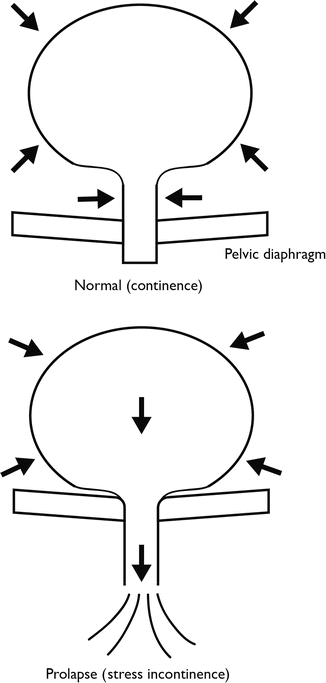and Paula Briggs2
(1)
Department of Obstetrics and Gynaecology, Monash University, Clayton, Victoria, Australia
(2)
Sexual and Reproductive Health, Southport and Ormskirk Hospital, Southport, UK
Incontinence
Definition
Incontinence is the involuntary loss of urine. It is divided into:
Stress incontinence – The involuntary loss of urine in association with raised intra-abdominal pressure, e.g. on coughing, sneezing, jumping, running etc.
Urge incontinence – The need to pass urine with little warning and occasional accidents. This is often associated with urinary frequency and having to pass urine at night (nocturia). Women with urgency will often “toilet map”. They also leak in specific situations e.g. putting the key in the lock of the front door or turning on the tap.
Mixed incontinence – This is when both stress and urge incontinence co-exist and this is not uncommon (Fig. 10.1).

Fig. 10.1
Types of incontinence
Asking simple questions can determine whether a woman has stress, urge or mixed incontinence.
Persistent incontinence- This occurs if there is a fistula of the urethra or the bladder with a constant leak of urine.
Incontinence with overflow – This is when there is a neurological or mechanical obstruction of the bladder, with the bladder over-distending and then leaking due to a build up of pressure.
Incidence
Approximately half of postmenopausal women report urogenital symptoms. These generally appear soon after the menopause transition and worsen with time.
Aetilogy and Pathogenesis
The aetiological shopping list is less appropriate for these symptoms. Oestrogens have a significant physiological effect on the genitourinary tract, with receptors in the bladder and urethra. Oestrogen can also affect the neurology of micturition on a central and peripheral level, by influencing the autonomic nervous system. Oestrogen affects collagen metabolism in the lower genitourinary tract. Progesterone generally adversely affects female urinary tract function, typically decreasing the tone in the ureters, bladder and urethra. This may be the reason why urinary symptoms worsen during the secretory phase of the menstrual cycle, and during pregnancy.
Stress Incontinence
The primary problem here is that the proximal urethra becomes extra-abdominal (Fig. 10.2). Whilst the proximal urethra is within the abdominal cavity, any increase in abdominal pressure, acting on the bladder will be neutralised by pressure on the proximal urethra. Once the proximal urethra is extra abdominal, there is no neutralisation, and consequently there is a pressure gradient along the urethra, and urine escapes.




